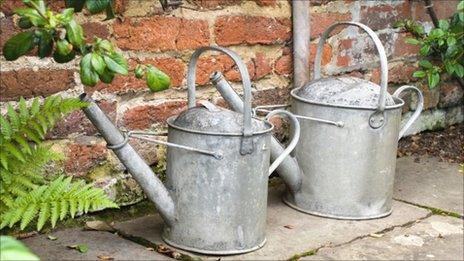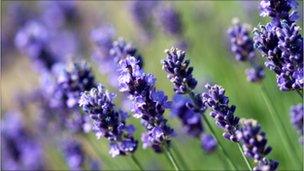Drought gardening: How will horticulturists cope?
- Published
- comments

Gardeners in the UK are facing a difficult summer after the driest spring in over 100 years. But how can home horticulturists cope?
Summer is a time of excitement for gardeners conjuring up manicured lawns, immaculate roses, and a cornucopia of other flora.
But this year the usual optimism is in danger of drying up.
Across England and Wales spring rainfall was 86.9mm - the driest since 1893, according to the Met Office. It's meant problems for gardeners.
The dry spring "knocked gardeners off balance", says Peter Gibbs, presenter of BBC Radio Four's Gardeners' Question Time. This menace contrasts with the usual threat of spring frosts.
Already this has meant gardeners have had to plant seeds quicker and be more selective when deciding what to plant. They also need to consider how plants that will fare well in a hot dry summer will do when the cold eventually returns.
"It's a confusing time for gardeners as a lot of things that can be put in are high risk and may not survive the winter," says Dr Phil Gates, a senior lecturer in botany at Durham University and gardening blogger.
This isn't the first time gardeners have been unsure of what to plant.
After the warm weather of 2007, gardeners became excited about what exotic plants they could grow. Banana and palm trees soon became in vogue.
But many did not survive the cold British winter. Gardeners are now re-assessing what to grow, suggests Leigh Hunt, principal horticultural adviser at the Royal Horticultural Society.
"When we first started talking about global warming, we were looking at the need to grow Mediterranean plants as they can cope with hot weather.
"But now erratic weather is the trend so we need to develop an approach of coping when the weather doesn't do what we expect."
Of the recent dry weather, East Anglia was the worst affected area in the country as it has seen the driest spring for 101 years.
And in Kent, the "garden of England", gardeners are having to take extra measures to preserve that status.

Lavender can flourish in dry weather conditions
Plants such as geraniums and petunias are flourishing, as are wild flowers, whereas water-absorbing busy lizzies and salvias have all been given the cut.
Gardeners are using hanging baskets with reservoirs to stop water seeping through the bottom as well as water retention tablets.
Mel Henley, head of parks and gardens for Tunbridge Wells Borough Council, says its staff had been adapting what was planted over the last few years.
"Because flowers themselves have a high impact, we don't want to lose that so we're putting permanent plants in with the flowers.
"This won't make it lose impact but it just means that it won't need as much water because herbs and shrubs don't need as much."
As an increase in average temperatures has seen the growing season extended, when to plant seeds has also changed.
So if you wanted your roses to bloom perfectly in June, you really would have had to have planted them in October rather than in March, so that the roots can be established and get a good soaking over the winter months.
Not all areas of the UK are suffering from the dry weather as Scotland has had 20% more rain than usual for spring.
"Scottish people have a much more sensible attitude towards it - they are not put off by bad weather," says Lesley Watson, RHS judge and owner of New Hopetoun Gardens near Edinburgh.
"Bananas and palms were never grown here as we're very realistic about what can and can't be grown in Scotland."